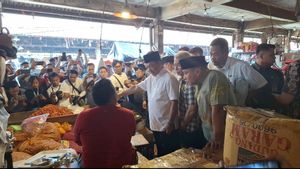JAKARTA - Agricultural observer from Sebelas Maret University (UNS) Surakarta Mercy Bientri Yunindanova said that Indonesia needed to think about alternatives to soybeans following the increase in prices for these commodities.
"We have to look for alternatives, cultivation cannot 100 percent meet domestic soybean needs because it requires a more integrated, uniform cultivation system and good management," said the UND Agricultural Faculty Agrotechnology Lecturer in Solo, Central Java, quoted from Antara, Tuesday. March 1st.
Thus, he said, there needs to be a process of diversifying food sources of protein by using alternative grains as raw materials that contain protein close to soybeans.
"Indonesia is very rich in the diversity of grain crops and it has been proven that it can be processed into tempeh. Actually, there is no need to worry because there is a lot of local wisdom about tempeh," he said.
In fact, he said, currently food technology has conducted research on the use of seeds other than soybeans for protein-rich foods such as tempeh.
"Indeed, its introduction to the public has not been massive, it must gradually (gradually) change the mindset that tofu and tempeh are not only made from soybeans. Protein can be obtained from other food ingredients, even food diversification in the sense of eating in various types is better," he said.
Meanwhile, he said, as a country that relies on imports, the increase in soybean prices should be a momentum.
"Because in the future the price of soybeans will increase with high world demand for soybeans because they are increasingly in demand in the world market," he said.
He said the world's high demand for soybeans was due to four factors, namely the use of biodiesel energy, the use of soybeans as animal feed, consumption in high quantities such as in China and America, and the trending plant based meat or plant-based meat products.
Regarding the development of soybean farming in Indonesia so far, he said, in terms of quality and quantity, it is lower than in other producing countries.
"This is because the majority of farmers in Indonesia plant individually, in different places with small land, and are not managed in the same system so that the yields are less uniform. Although some have been coordinated by Gapoktan (a combination of farmer groups), the quality variation and the quantity is still low," he said.
He said soybean productivity in Indonesia is quite low, around 1.5 tons/hectare and a maximum of 1.6 tons/hectare in Java.
"When compared to Brazil and America as the leader of soybean producers, the production reaches 3.5 tons per hectare," he said.
The English, Chinese, Japanese, Arabic, and French versions are automatically generated by the AI. So there may still be inaccuracies in translating, please always see Indonesian as our main language. (system supported by DigitalSiber.id)












